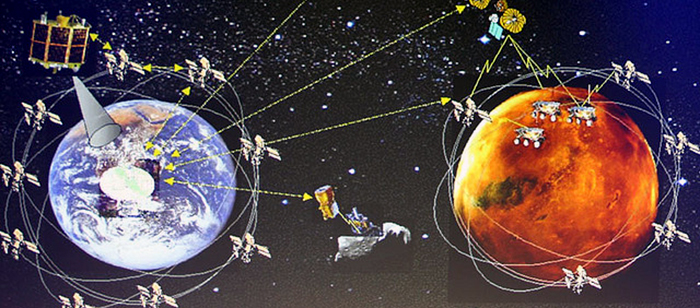
Dissertation Defense
Virtual Circuit Provisioning in Challenged Sensor Internetworks:
with Application to the Solar System Internet
Ed Birrane
10:00am-12:00pm Monday, 11 August 2014, ITE325b
In this thesis, we present a challenged sensor internetwork (CSI) networking architecture which federates heterogeneous constituent networks behind an overlay routing mechanism abstracted from individual data link layers. The CSI is unique and required to implement expanding sensor networks.
Demand for sensing networks with increasing spatial footprints is evidenced by ongoing efforts to build geo-political border monitoring networks, intelligent highway initiatives, automated undersea surveillance, and NASA effort to construct a Solar System Internet. Existing network technologies fail to address multiple physical links, frequent disruptions, and significant signal propagation delays. The construction and maintenance of virtual circuits in an internetwork abstracted from differences in the physical, data-link, and transport layers of an internetwork represents a unique research contribution with immediate utility for a wide variety of sensing network concepts.
We describe the CSI architecture as the intersection of wireless, delay-tolerant, and heterogeneous networks and describe special characteristics of this architecture than enable useful assumptions to optimize messaging. We define an internetwork routing (INR) framework that decomposes the routing function into discrete logical steps and we provide algorithms for each of these steps. An inferred Contact Graph Routing (iCGR) algorithm populates logical graphs from local nodes. A Contact Graph Routing with Extension Blocks (CGR-EB) algorithm provides a hybrid source-path algorithm for synchronizing link state along network paths. A Predictive Capacity Consumption (PCC) algorithm exploits CGR-EB data to build a congestion model. Payload Aggregation and Fragmentation (PAF) and Traffic-Shaping Contacts (TSC) algorithms condition data and place limits on the amount of internetwork traffic carried over local networks.
From simulation, iCGR performs within ~15% of a perfect-knowledge system. CGR-EB has a speedup over standard approaches by 300% in stable topologies, by 3000% in unstable topologies, and by 11000% in unstable topologies with non-monotonic cost functions. PCC delivers 97% more data in congested networks over table-based approaches and 37% more data than the INR framework without the congestion model. PAF/TSC reduces message count by 43% while increasing goodput by 63%.
Together, these algorithms build and monitor virtual circuits in the CSI architecture. Portions of this work are in consideration for deployment in NASA networks.
Committee: Drs. Alan Sherman (Co-Chair, UMBC), Mohammed Younis (Co-Chair, UMBC), Dhananjay Phatak (UMBC), Vinton Cerf (Google), Keith Scott (MITRE), Hans Kruse (OU)